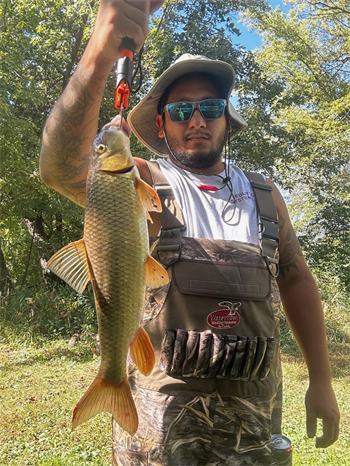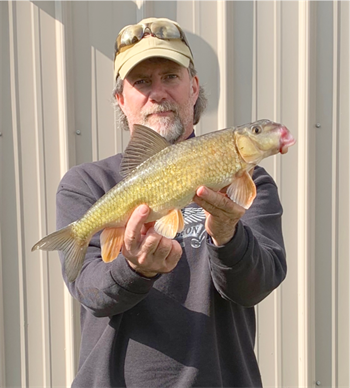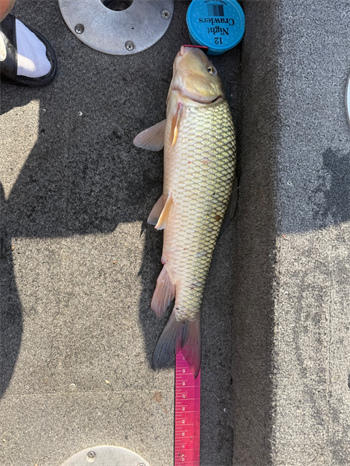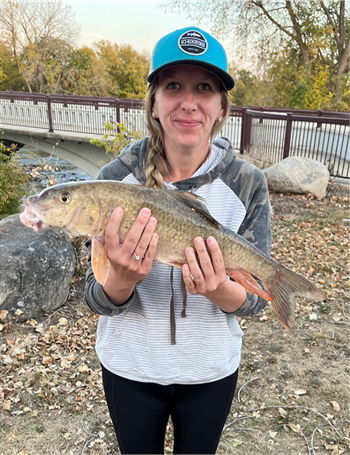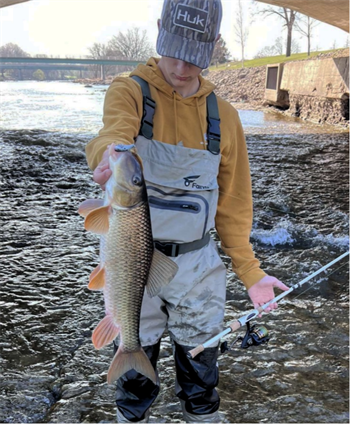Fish Iowa - Fish Species - Golden Redhorse
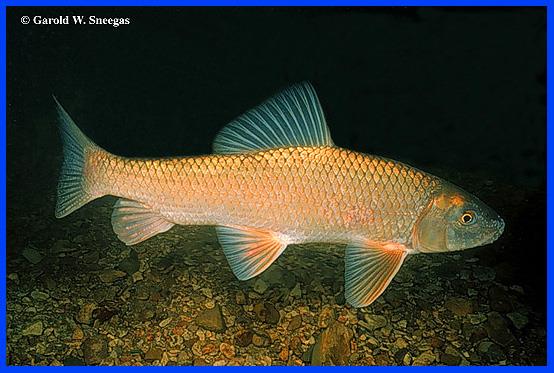
Characteristics
A slightly chubby, coarse-scaled sucker colored light-yellow to bronze. The scales on the back and sides are without dark spots on the base. It can be separated from the Silver Redhorse by the outer margin of the dorsal fin, which is slightly curved inward and has 12 to 13 (rarely 14) rays. The ridges on the lips are continuous and not broken by transverse creases into small papillae. The lateral line is complete with 39 to 42 scales. The tail fin is slate or pale-yellow, and the air bladder has three chambers.
Foods
Almost exclusively aquatic insect larvae and small mollusks.
Expert Tip
Hook and line anglers generally only take suckers during early spring spawning runs, and more commonly in northeast Iowa rivers and streams.
Details
The Golden Redhorse prefers pools and low raceways with clear, gravelly or rocky bottoms in creeks or small rivers of medium gradient and enough current to prevent rapidly accumulating silt. The habitat of the Golden Redhorse is similar to that of the Black Redhorse, but prefers slightly warmer waters with less current, and is more tolerant of large rivers, turbidity, and intermittent flow. Researchers in Missouri have found that it reaches highest abundance in streams with large permanent pools and firm, well-defined rocky or gravelly riffles. The Golden Redhorse is intolerant of continuous turbidity, rapid siltation, and industrial pollutants, but because of its highly migratory nature, it can live in streams with considerable industrial pollution.
Golden Redhorse go to small streams in late April or May to spawn when water temperature is 60 to 72 degrees. They are gregarious spawners, broadcasting the semi-adhesive eggs over gravel or rubble substrates in the shallow riffles. Eggs are left unattended to hatch. The age of maturity is variable with some males maturing in the third year and females one year older. An 18-inch female produces around 21,000 eggs. Growth of Golden Redhorse in the upper reaches of the Mississippi River is 2.2-inches in the first year, 15.6-inches at the fifth year and 19.3-inches at 8 years of age.
Recent stream sampling information is available from Iowa DNR's biological monitoring and assessment program.
Sources:
Harlan, J.R., E.B. Speaker, and J. Mayhew. 1987. Iowa fish and fishing. Iowa Conservation Commission, Des Moines, Iowa. 323pp.
Loan-Wilsey, A. K., C. L. Pierce, K. L. Kane, P. D. Brown and R. L. McNeely. 2005. The Iowa Aquatic Gap Analysis Project Final Report. Iowa Cooperative Fish and Wildlife Research Unit, Iowa State University, Ames.
Photo Credit: photo courtesy of Garold W. Sneegas, copyright Garold W. Sneegas.
Distribution Map

Statewide; most abundant in small to moderate-sized streams in the more forested parts of northeast Iowa. Commonly found in the middle reaches of the Mississippi River, but is rare in the more turbid waters of the Missouri River basin.
See our most recent distribution data for this species on the Iowa DNR's Bionet application.
State Record(s)
Master Angler Catches
Fish Surveys
Tip: Click Species Length by Site, then use the dropdown to filter by fish species of interest.Where this Fish Is Found
Bear Creek
Cedar River (Cedar Rapids to Moscow)
Cedar River (La Porte City to Cedar Rapids)
Des Moines River (Saylorville to Red Rock)
East Fork Des Moines (Algona to Humboldt)
Iowa River (Coralville Lake to River Junction)
Iowa River (Iowa Falls to Marshalltown)
Missouri River (Council Bluffs to state line)
Missouri River (Little Sioux to Council Bluffs)
Missouri River (Sioux City to Little Sioux)
Spring Creek
Trout Run
Turkey River (below Clermont)
Upper Dam Impoundment
Upper Iowa River (above Decorah)
Upper Iowa River (below Decorah)
Volga River
Wapsipinicon River (state line to Tripoli)
Wapsipinicon River (Troy Mills to Oxford Junction)
West Fork Cedar River
Winnebago River
Yellow River (Trout Section)
